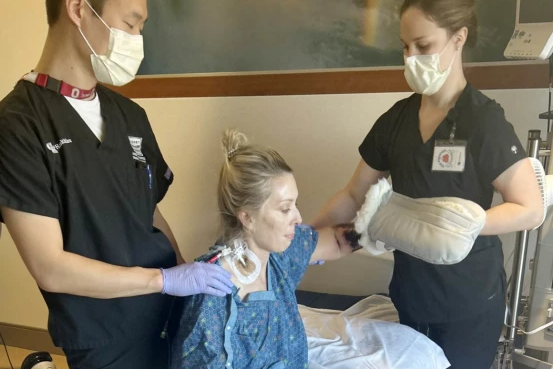
Lucinda Mullins’ life-changing ordeal began with a kidney stone the size of a grain of sand.
It set off an infection and sepsis, leaving the Kentucky mom on life support and ultimately forcing doctors to amputate her legs in December. Her arms will have to be amputated, too.
“It’s one of the worst-case scenarios that can happen, and it just happened to me,” Mullins, 41, who lives in Stanford, Kentucky, tells TODAY.com.
“(But) I’ve never been so happy to be alive. If this is a sacrifice that I had to make to be alive, to see my family, to see my friends, to see my kids grow up, I’m at peace and I’m OK with it.”
Mullins’ story has received national attention after it was first reported by NBC affiliate WLEX.
Kidney stones come with the risk of a kidney infection, which can lead to sepsis, the body’s life-threatening response to infection, the Sepsis Alliance warns.
But experts say such severe cases don’t happen very often.
“Severe sepsis and amputation following a kidney stone is rare and should not be considered as a common or expected complication of kidney stones in general,” Dr. Sylvia Rosas, a Boston nephrologist and president of the National Kidney Foundation, tells TODAY.com.
Frightening symptoms
Mullins, who is a nurse, says she didn’t have any health problems before she was diagnosed with kidney stones in both of her kidneys in 2023 after experiencing some back pain.
When the stones began to be more bothersome in the fall, her urologist recommended preventative surgery to remove them.

In October, Mullins had the procedure done on her left kidney, which contained more stones. Everything went fine.
Surgery on the right kidney took place on Dec. 1. This time, doctors told her they couldn’t see the stones, but it was nothing to worry about, she recalled. Mullins left with ureteral stent — a thin tube that helps the kidney drain urine after kidney stone surgery, according to the Urology Care Foundation — placed inside her body.
She took it out at home a couple of days later, as instructed, and started feeling sick. By Dec. 5, she had a high fever, vomited and had back pain. Her husband found her lying on the bathroom floor drifting in and out consciousness, and drove her to the emergency room.
Mullins’s blood pressure was 50/31 — dangerously low.
“They did a CT scan to find out what was going on, and that’s when they saw the kidney stone that was lodged in there with enormous amounts of infection behind it,” DJ Mullins, her husband, tells TODAY.com.
‘Her whole body was shutting down’
A person who has undergone a urological procedure to remove a stone can develop an infection afterward, Rosas says. If urine becomes infected with bacteria, it can then infect the stone. And the stone can also obstruct the kidney from draining, she adds.
The infection needs to be treated immediately because patients can become septic quickly, which is life-threatening, Rosas warns.
Lucinda Mullins was sedated, intubated and stabilized enough to be transferred to a bigger hospital in Lexington, Kentucky.
There, doctors told her husband she was in septic shock, the most severe form of sepsis, according to the Sepsis Alliance. She had multiple organ failure, including kidneys, liver and lungs. The mom required a ventilator, dialysis and an ECMO heart-lung machine.
“Her whole body was shutting down,” DJ Mullins recalls. “She lay there sedated for about a week, not moving a muscle, (us) not knowing if she was going to live because the machines were doing everything for her.”
To combat her dangerously low blood pressure, Lucinda Mullins received vasopressors, drugs used in the intensive care unit to narrow blood vessels, raise blood pressure and send blood to vital organs, according to the Cleveland Clinic.
But when these medications pushed blood to her core, it was at the expense of the circulation in her extremities, her husband says.
“It was basically life over limb,” DJ Mullins explains. “That circulation (in her arms and legs) never did come back.” Discoloration and dead tissue set in.
When Lucinda Mullins was taken off the ventilator and regained consciousness, she asked the doctor to “shoot it to me straight.”
“He told me that in order to save my life, they had to give me medication; that in return, I was going to lose my limbs,” she recalls.
“I just had this peace. I just felt this presence of God with me telling me it was going to be OK. I was alive, and if that was the sacrifice that I had to make to be alive, I was OK with that. I wasn’t angry. I wasn’t upset.”
Both of her legs were amputated above the knee on Dec. 13.

Preparing for new life
Two stones, each the size of a grain of sand, were ultimately removed from her right kidney. One of them caused the ordeal. “All that over that,” DJ Mullins says.
Lucinda Mullins still faces surgery to amputate her arms, with doctors hoping to save her elbow joints because that will make it easier to use prosthetics. All of her organs are working fine after that frightening time in the ICU.
She is still in a rehabilitation hospital in Lexington, where she’s been learning how to control a power wheelchair with her head, strengthening her core and working on her balance.

She finally gets to go home Jan. 12 for the first time since she was hospitalized in early December. Her first goal is to go to church on Sunday.
“Without my faith, there’s just no way I could be where I’m at today,” she says.
Friends of Lucinda Mullins have set up a GoFundMe page for the family to help with medical and other expenses.










